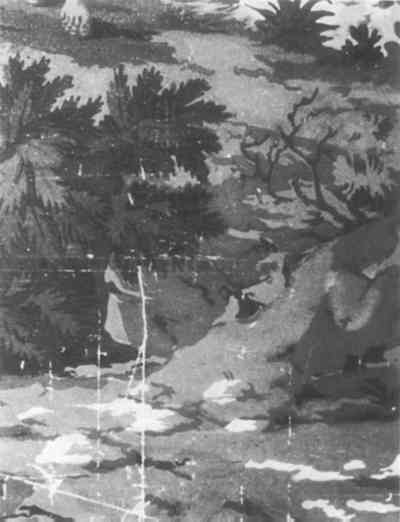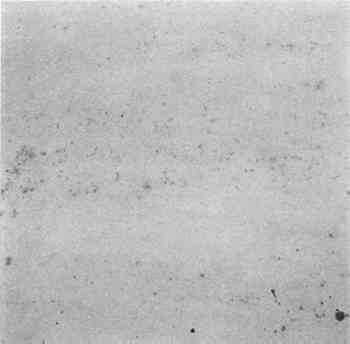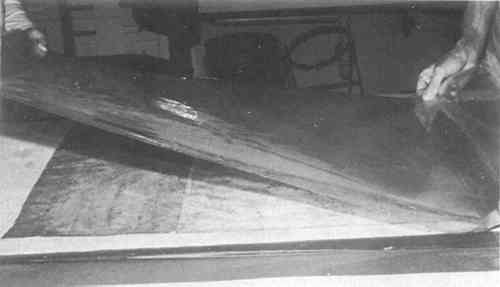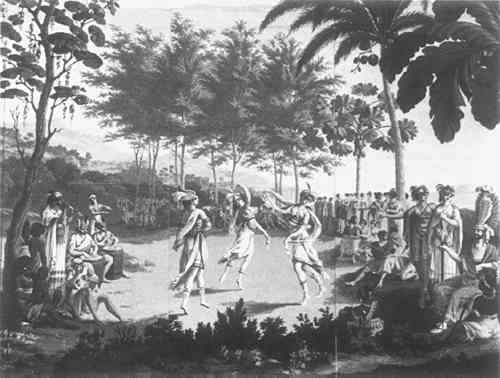CONSERVATION OF SCENIC WALLPAPERS: SAUVAGES DE LA MER DU PACIFIQUERobert Futernick
ABSTRACT—The history, method of manufacture, treatment, repair, mounting and display of a rare set of scenic wallpapers is discussed. Mold discoloration and other products of age causing staining were reduced by immersion in a water bath. Tears were repaired and missing areas filled. The 20 panels comprising the set of Dufour wallpapers were supported with several layers of lining material (Japanese paper and polyester web) and finally attached to custom-made light weight solid panels for permanent museum installation. 1 INTRODUCTION AND HISTORICAL BACKGROUNDCAPTAIN JAMES COOK OF THE ROYAL NAVY first sailed from England to the South Sea Islands in 1769. Altogether he made three expeditions before his death in 1779. Cook's adventures captured the imagination of many Western Europeans at a time when there was considerable interest in the primitive and exotic. His discoveries lent support to the prevailing notion of the inherent moral superiority of “the noble savage,” an idea expressed in the writings of Jean-Jacques Rousseau ((1712–1778). In 1784, accounts of Cook's voyages were set forth in an official three-volume publication. Accompanying this was a separate folio atlas containing sixty-one engravings of landscapes, portraits, and indigenous artifacts. This documentation provided the imagery that was later to be translated into the “picturesque.” In a effort to satisfy a growing demand for the exotic, it is not surprising that in 1806 a French painter, Joseph Dufour, collaborating with a designer, Jean-Gabriel Charvet, chose to commemorate Cook's exploration in the production of a twenty-panel set of scenic wall papers entitled Sauvages de la Mer du Pacifique (“Savages of the Pacific”). Dufour realized almost immediate success from the sale of these papers and enjoyed a lively trade with America. The Neoclassic spirit currently in favor was accented handsomely in houses of the Federal period by the exaggerated elegance of Charvet's scenes. Machine-made continuous paper, just invented, was not yet commercially available when Dufour undertook his project. Instead, small rectangular handmade sheets were joined at the edges to form long rolls which were later cut to the desired length (approximately 24″ by 98″ or 61 � 249 cm). A toned, water-based ground layer was then applied by brush to the entire panel to act as an undercoat for subsequent printing. This light blue layer also served as the sky tone in unprinted areas. Designs for each color were carved on separate blocks, and as many as sixty were required to print a single panel. Alignment of the many blocks must have been a significant problem, especially considering the expansion characteristics of the paper support. With the printing of each water-based color, the paper expanded in reaction to the moisture. It is quite remarkable, then, that Dufour was able to achieve such a precise degree of registration. Guide marks found in the unprinted edges of each panel partially indicate how this technical difficulty was overcome. Dufour achieved a richness and intensity of color that was unique to this method of production. However, the extreme thickness of the media application and its solubility in water presented problems in hanging the paper, and later would create difficulties for those involved in the preservation and display of Dufour's Sauvages de la Mer du Pacifique. 2 THE SAN FRANCISCO SET OF DUFOUR WALL PAPERSFEW SETS of the Cook papers have survived intact. The Fine Arts Museums of San Francisco were fortunate to acquire eighteen panels of the twenty-panel set in 1977 for placement in its new American Galleries. Other existing sets have suffered considerable damage during the past 170 years. Alteration to fit specific room dimensions, fading of color as a result of long exposure to intense light, accumulation of surface soiling, and mechanical damage occurring in hanging or removal are not uncommon maladies. By comparison, the Musuem's newly acquired papers were in remarkably good condition. Only two, numbers 14 and 15, had ever been substantially trimmed or affixed to a wall surface. The remaining panels have retained the full height and grandeur of Charvet's design, distinguishing this set as a unique example. However, specific problematic conditions did exist upon acquisition, and major conservation treatment was required before installation could occur. In February of 1977 the Cook papers were brought to the Museum's graphic arts conservation laboratory for examination and treatment. Since the American Galleries were to open in June we knew that work would have to proceed rapidly if the installation deadline was to be met. There were times when completion of the project seemed an impossible task. The sheer size and number of the paper panels created problems at every turn. Compounding this, almost no precedent for the conservation of scenic wall-papers was available either in the literature or to be gleaned through consultation with other conservators. Except for a concurrent project at Hawaii's Pacific Regional Conservation Center which generated an exchange of helpful information, most of the conservation methodology had to be formulated as the treatment progressed. 3 CONDITIONTHE WALLPAPER had been rolled and placed in storage for many years. Although this measure protected the pigments from light damage, horizontal crack patterns with associated flaking media resulted from the strain caused by the rolled position. Additional cracking of the thick and brittle design coating was apparent on most of the panels (Fig. 1). Handling may have caused this condition, but the differential responsiveness of the thick media and its paper support to changes in humidity created the propensity for damage.
Examination of the reverse of the wallpapers indicated extensive mold staining (Fig. 2). In certain heavily affected areas, discoloration had migrated from the paper, becoming visible in the design. Both the material used as a pigment binder and the paper support itself provided nutrition for the mold growth which was especially stimulated during periods of warm temperatures and high humidity. Additional darkening and soiling was apparent on the surface, resulting from periods of direct exposure to the atmosphere. The paper and water-based pigments
Weakness of the paper was also noted upon examination. This condition is to be expected as any paper ages, but the incidence of mold increased the rate of degradation; and when paper is weak, it is more prone to mechanical abuse. Most of the eighteen panels had suffered multiple tears and small paper losses. 4 TREATMENTOF THE SEVERAL CONSERVATION principles that have come into general acceptance, the main tenet includes the concept that a procedure should not materially alter the character of an object, and that any method used could later be reversed without difficulty or risk to the art. At the outset of treatment of the Dufour papers, we hoped that some reduction of the mold staining and surface soiling would be safely We immediately experienced a setback. Test procedures indicated that because of the extreme water-solubility of some of the colors, plans to wash and release discoloration and acidity could not proceed. It was also learned that even minimal application of moisture to the reverse sides, necessary for other treatment procedures, caused certain soluble elements in the paper to move through the paint layer and become visible in the design. Treatment came to a standstill. It was at this time that consultation with conservators from the Pacific Regional Conservation Center proved most beneficial. The papers being treated in Hawaii were in much worse condition than ours. Flaking media was an extensive problem, but the conservators there were having success with the application of a very dilute, non-yellowing acrylic resin. A small amount of this material, dissolved in a non-aqueous solvent, could deeply penetrate paint layers, reattaching and consolidating loose media.1 No visible change in coloration occurred, and with the addition of this non-aqueous binder, the design became resistant to moisture. Water washing was now possible, and by incorporating this technique devised in Hawaii, we were able to proceed with the actual treatment.
1 2% B-72 w/v dissolved in solvent (toluene and xylenes, 50–50) was spray applied to paint surface. We constructed a sink large enough to accommodate one 24″ � 98″ panel.
2 Sekishu paper, 100% mulberry fibers, .005-inch in thickness.
The first day of washing saw only one panel bathed and lined. This rate of progress was viewed with dismay since the exhibition deadline was fast approaching. However, examination of the first washed panel, after drying, created no small amount of excitement and surprise. We had thought that when the fixative was applied, a portion of the existing discoloration would be bound into place. Instead, the water was able to dissolve and remove nearly all of the staining. A freshness of color was achieved that probably had not been seen since the time of the papers' printing. And as the days passed, our technique quickened. We were able to wash, line, and begin to dry upto four rolls in one day. Drying these large panels, as one might imagine, was cumbersome. Absorbent blotting paper had to be changed at regular intervals, and this meant dismantling our elaborate pressing and weighting system each time. This “system” consisted literally of a pile of bricks, a typewriter, lead weights, jugs of water and other laboratory items sufficiently affected by gravity, all set atop the blotting papers and plywood boards pressing the drying wallpapers. To provide additional strength, and to limit tightening and buckling with humidity changes, a secondary synthetic support system consisting of an inert polyester fabric3 and a temperature-sensitive adhesive4 was applied. A vacuum hot table, most often used for lining oil paintings, provided the necessary heat and pressure.
3 Reemay from duPont; non-woven polester web, No. 2114.
4 PVA Resin, AYAA-AYAF (50–50) in toluene. 5 PREPARATION FOR INSTALLATIONDISPLAY MOUNTS for the panels were first constructed of a resin-sealed wooden lattice structure that was then covered on both sides with acid-free cardboard and paper. They were made to accommodate the height of the taller panels. Paper toned to match the sky had been added to the shorter rolls, bringing them to the proper measurement. The width of the mount was made to match the dimension relating to the design area of the wallpapers. In this way, the unprinted margin could be preserved by turning it onto the edge of the display mount. The panels could then be placed in close contact to achieve proper alignment of the images. Problems developed, however, because the width measurement for each panel varied. Creasing and folding all of the papers to a standard dimension meant that part of the image on many sections would be lost. To compensate, each mount was shimmed to the appropriate width by adding the necessary thickness of paper or rag board to the edge. The last phase of treatment, attachment of the wallpaper to the display mounts, was undertaken. The plan was to stretch the lined papers across the mounts much the way a canvas is prepared for oil painting. Pins were to be temporarily placed through the extending lining into the edge of the mount. The entire panel would then be turned face down and the protruding lining stapled to the reverse. Two sections were mounted in this way and all seemed fine until the next day when We still had the question of what to do about the two missing sections, numbers 8 and 16. Mounts were constructed, and a well known scenic artist, Garth Benton, was employed. With the aid of color transparencies he reproduced the missing panels to near perfection. Viewed along-side the originals, the fascimiles are difficult to detect. One final dilemma remained. The original exhibition scheme included placement of the Dufour paper on the walls of the recently acquired Newburyport room. To proceed with this plan would be to face the same problem that has arisen for as long as scenic wallpapers have been printed in standard sizes and later installed in rooms of differing dimensions. Contemporary papers pose little problem. They can be trimmed to match room specifications as necessary. Dufour wallpapers, however, have emerged as rare and important historic objects, indicated in part by the great care given them in conservation. The idea of trimming even the unprinted margins, much less the extensive sky region, was out of the question. At one point, consideration was given to elevating the ceiling, but this also was unacceptable if the parlor's
ACKNOWLEDGEMENTSTHE SUCCESS of this project would not have been possible without the inspired help of an entire group of conservators and technicians. Interaction of paper and painting conservators yielded a treatment result that was far superior than could be achieved without that cooperation. Those most directly responsible were James Bernstein, Niccolo Caldararo, Debbie Fox, Leslie Kruth, Mary Wood Lee, Pauline Mohr, Brenda Palley, Mark Tucker, and Melinda Tucker. REFERENCESClareCrick, “Two Wallpapers by Dufour et Compagnie,” Pharos '78, June 1978, Museum of Fine Arts, St. Petersburg. Mary WoodLee, KonstanzeBachman, and ShelleyFletcher, “Sauvages de la Mer du Pacifique: Treatment of an early 19th century wallpaper depicting the voyages and death of Captain Cook,” AIC preprints, Boston, Mass., pp. 92–103 (May 30–June 2, 1977). NancyMcClelland, Historic Wall-papers: From Their Inception to the Introduction of Machinery, Lippincott, 1924. For further reading, see CatherineLynn, Wallpaper in America from the Seventeenth Century to World War I, 1980, W.W. Norton & Company, Inc.New York.
 Section Index Section Index |



